Your Guide to the Captain Cook Snorkel Tour
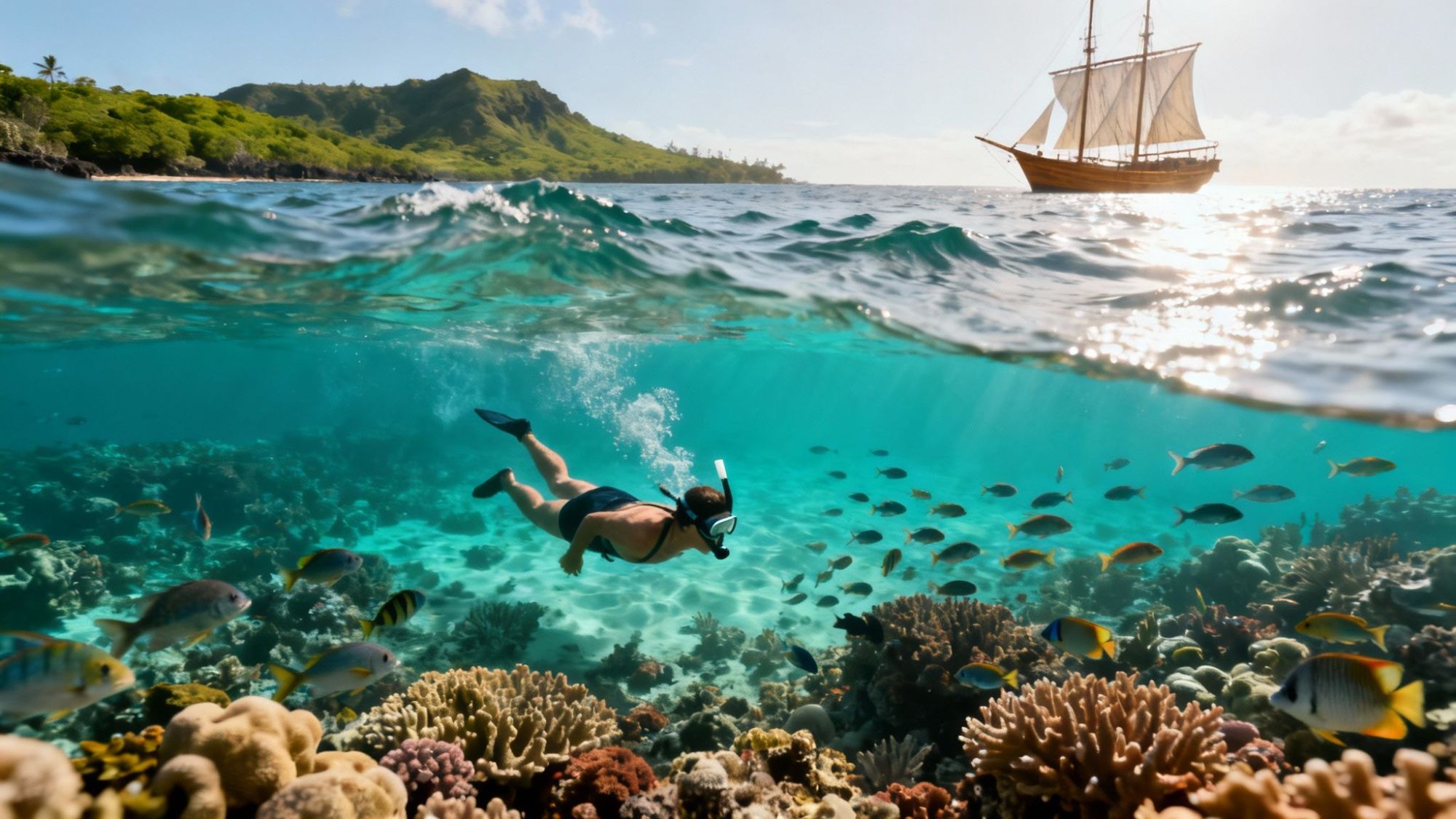
Picture this: you're floating weightlessly in calm, crystal-clear turquoise water. Schools of impossibly bright tropical fish drift by, completely unbothered by your presence. This is the essence of a Captain Cook snorkel tour—a classic Big Island experience that’s so much more than just putting on a mask and fins. It’s a perfect blend of stunning natural beauty and a real-deal connection to Hawaiian history. It’s an adventure you won’t soon forget.
Why This Snorkel Tour Is a Must-Do Big Island Adventure
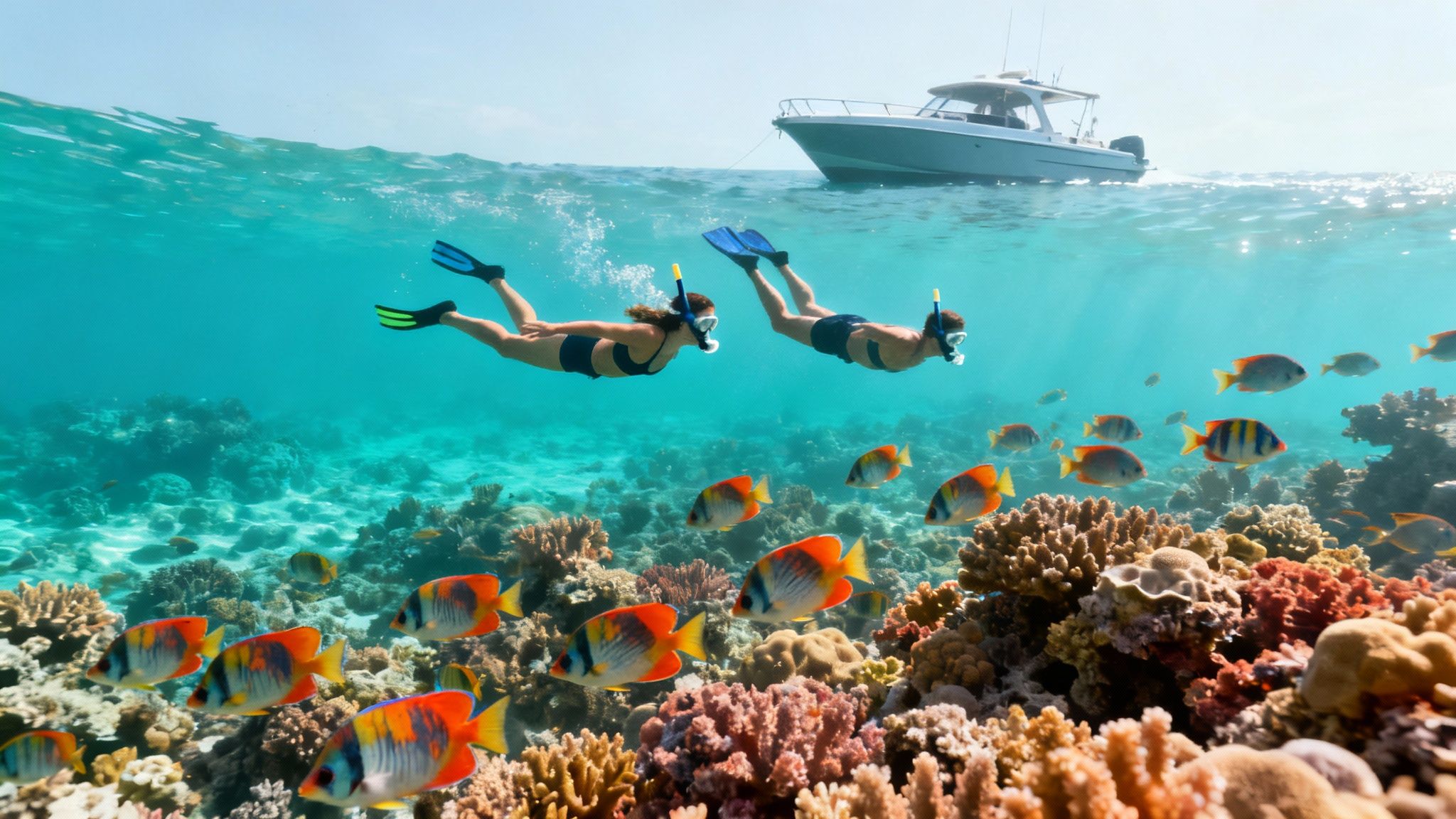
A Captain Cook snorkel tour isn't just another item to tick off your vacation list; it’s a journey to one of the most historically and ecologically important spots in all of Hawaii. We're talking about Kealakekua Bay, home to the iconic Captain Cook Monument. The whole area is a protected marine sanctuary, which means the underwater world you’ll find here is exceptionally healthy and packed with life.
Unlike a lot of snorkel spots you can just walk to from the shore, the absolute best part of Kealakekua Bay is only reachable by boat. That remoteness is a huge part of its magic. The water is usually flat calm and incredibly clear, with visibility that often pushes past 100 feet. It's like swimming in a giant, natural aquarium—perfect for everyone from first-timers to seasoned pros.
A Fusion of History and Nature
What really makes this trip special is how it mixes jaw-dropping nature with a palpable sense of history. This bay is a big deal, drawing over 190,000 visitors every year. This is where Captain James Cook, the famous British explorer, first made contact with Hawaiians in 1779. For a lot of people, that historical weight turns a simple snorkel outing into a pilgrimage to a pivotal place in Hawaiian and world history. You can dive deeper into the story of this landmark on konahonudivers.com.
The secret to the bay's incredible vibrancy is its official designation as a Marine Life Conservation District. This protection is what keeps the coral reefs healthy and the fish populations booming, giving us a glimpse of what Hawaiian reefs looked like generations ago.
To give you a snapshot of what to expect, here’s a quick rundown of the highlights.
Captain Cook Snorkel Tour Highlights
| Feature | Description |
|---|---|
| Pristine Marine Sanctuary | Swim in a protected bay with incredibly healthy coral reefs and massive schools of tropical fish. The marine life is abundant and unafraid of snorkelers. |
| Exceptional Water Clarity | Experience some of the clearest water in Hawaii, often with visibility exceeding 100 feet. Perfect for seeing everything the reef has to offer. |
| Historical Significance | Snorkel right next to the Captain Cook Monument, the site where the famed British explorer first landed on the Big Island in 1779. |
| Remote and Uncrowded | Because the best snorkeling is boat-access only, the spot feels secluded and peaceful, far from the busy roadside beaches. |
| Wildlife Sightings | The boat ride along the Kona coast often includes bonus sightings of spinner dolphins, and in the winter, even migrating humpback whales. |
This tour truly has it all, from the moment you step on the boat to your last glimpse of the underwater world.
What Makes the Experience Unforgettable
Honestly, the journey to the bay is part of the fun. The boat ride down the stunning Kona coast is an adventure in itself. Keep your eyes peeled for spinner dolphins jumping in the boat's wake or, if you're here in the winter, the unmistakable spout of a humpback whale.
As you pull into the bay, you'll see it: the striking white obelisk of the Captain Cook Monument set against dramatic, ancient sea cliffs. That's your landmark for the day's underwater exploration. This guide is your complete playbook for planning the perfect trip, covering everything from picking the right tour to identifying the fish you'll meet. Think of it as your insider’s guide to one of Hawaii's most legendary adventures.
Exploring the Rich History of Kealakekua Bay
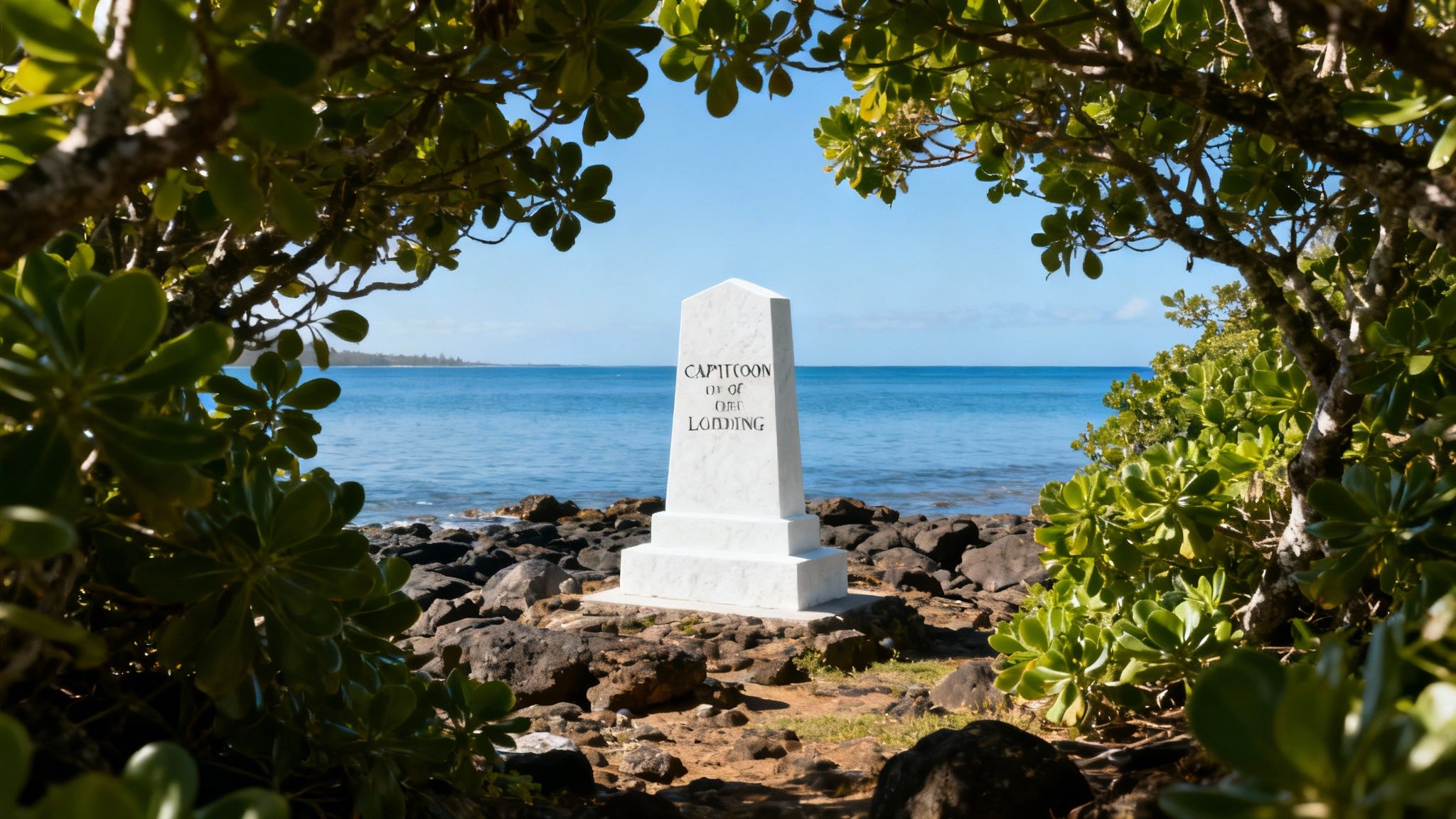
When you slip into the calm, clear waters of Kealakekua Bay, you're doing a lot more than just snorkeling. You're floating through a living museum, a place where some of the most critical moments in Hawaiian history went down. The bay’s story is just as deep and vibrant as the coral reefs below, which turns your Captain Cook snorkel tour from a fun day on the water into a real journey through time.
Long before Western ships ever appeared on the horizon, Kealakekua Bay was a place of immense spiritual and political power. Its very name, Kealakekua, translates to "the pathway of the god," giving you a hint of its sacred status. This was a center for Hawaiian royalty and a major religious site.
The massive cliffs framing the bay, called pali, weren't just a dramatic backdrop. They held ancient burial caves for chiefs, and the fertile land all around the water supported a busy, thriving community. It was a place of power, ceremony, and daily life for generations of Hawaiians.
A Sacred Place of Refuge
One of the most vital roles Kealakekua Bay played back in the day was as a puʻuhonua, or a place of refuge. Think of it like a sanctuary, a designated safe zone where anyone who had broken a sacred law, known as kapu, could find total forgiveness and safety.
This idea was a cornerstone of Hawaiian society. If a commoner accidentally crossed the shadow of a chief, or a warrior was defeated in battle, they could be absolved just by reaching the boundaries of the puʻuhonua. It was a system that provided a crucial element of mercy within a very strict social structure.
The Arrival of Captain Cook
The bay's tranquil existence was changed forever in January 1779 with the arrival of Captain James Cook and his two ships, the HMS Resolution and HMS Discovery. His timing was incredible—he showed up right in the middle of the Makahiki festival, a peaceful season honoring Lono, the Hawaiian god of fertility, agriculture, and peace.
When the Hawaiians saw Cook's impressive ships with their tall masts and white sails, they welcomed him with huge ceremony, maybe even thinking he was a physical manifestation of Lono himself. For weeks, things were peaceful and prosperous. The Hawaiians generously gave the British sailors provisions, a warm welcome that guides on a Captain Cook snorkel tour love to share.
The first interactions between Cook’s crew and the Hawaiians were a complex cultural exchange. What the British saw as simple trade, the Hawaiians might have seen as offerings to a god. These were the kinds of misunderstandings that would later lead to tragedy.
But that initial goodwill started to wear thin. Cultural misinterpretations and the sheer strain of supporting hundreds of sailors took a toll. The whole dynamic shifted from reverence to tension.
A Fateful Encounter
After leaving the bay, Cook's fleet had to turn back for repairs when a ship's mast snapped in a storm. By this point, the Makahiki festival was over, and the Hawaiians' view of Cook had soured. Tensions boiled over quickly, starting with a confrontation over a stolen cutter boat.
On February 14, 1779, a fight broke out on the shore of Kaʻawaloa—the exact spot where you'll be snorkeling. In the chaos that followed, Captain James Cook was killed.
Today, a striking 27-foot white obelisk stands right where he died. And here's a fun fact: the small piece of land the monument sits on was actually deeded to the United Kingdom, so it's technically British soil. Knowing this complex past makes every moment in the water feel richer, connecting you directly to the layers of history just beneath the waves. You can dive deeper into the bay's importance in our guide to the Kealakekua Bay snorkeling tour.
What You'll See in This Underwater Paradise
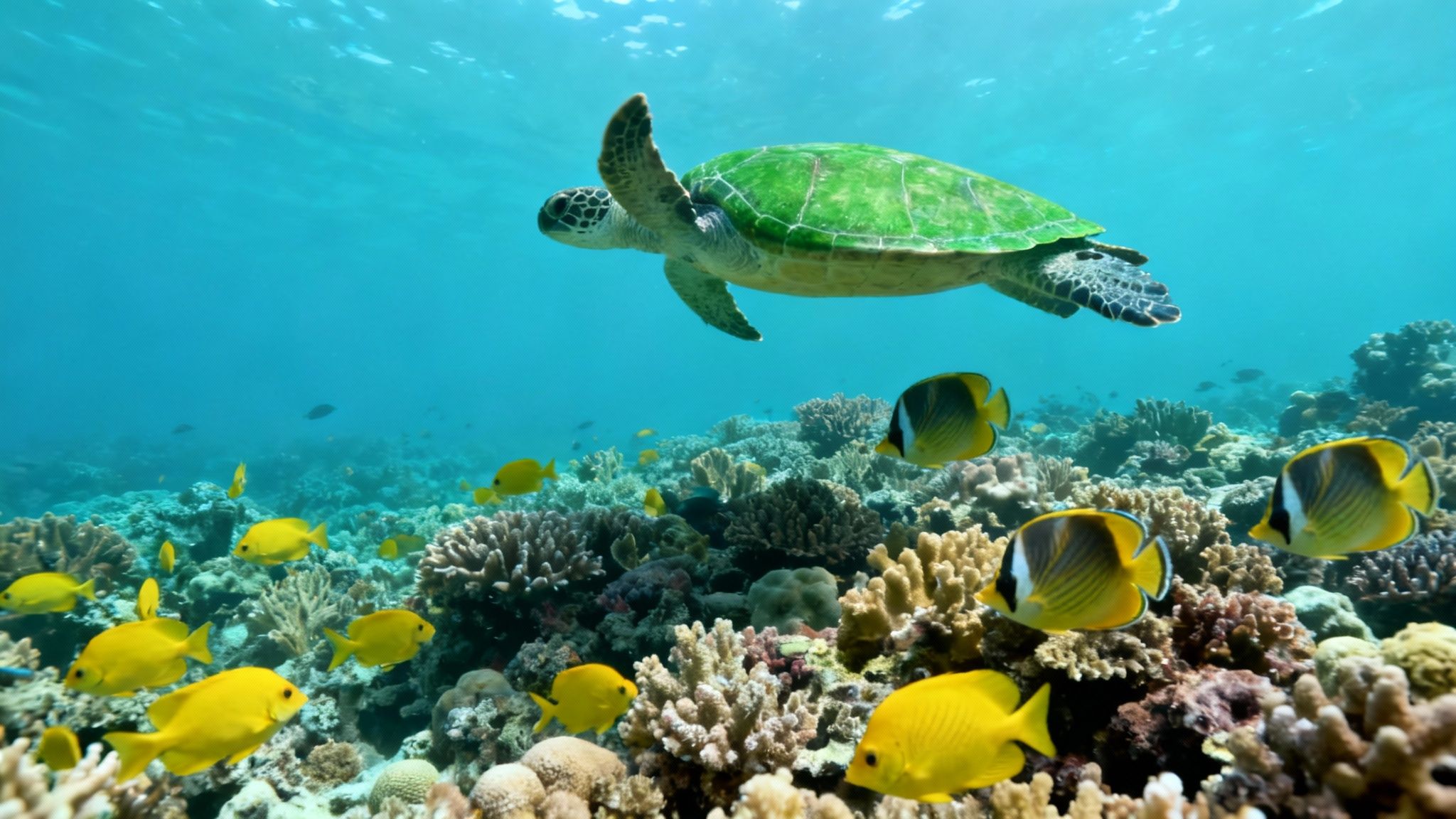
The moment you slide into the water on a Captain Cook snorkel tour, it’s like being dropped into the world's most pristine aquarium. Your mask hits the surface, and the world above disappears, replaced by a bustling underwater city teeming with color and life.
This isn't just a random spot in the ocean; Kealakekua Bay is a protected Marine Life Conservation District. Think of it as a national park, but for fish. Because of this special status, the ecosystem is incredibly healthy, the coral is thriving, and the marine life is everywhere—and surprisingly unafraid.
The Coral Gardens Foundation
The whole show is built on a foundation of sprawling coral reefs. These aren't just rocks; they're living colonies of tiny animals that have spent centuries building intricate, otherworldly structures. These coral gardens are the apartment buildings, restaurants, and playgrounds for hundreds of different species.
As you float above the reef, you'll see an amazing variety of shapes and textures. Some corals look like delicate, branching trees, while others form massive mounds that look like giant brains. This complexity is what provides shelter for tiny fish and food for others, making it the bedrock of the entire food web here.
A Rainbow of Reef Fish
The first thing that will blow you away is the sheer number of colorful reef fish. Massive schools move together in perfect unison, flashing in the sunlight. You don't have to be a marine biologist to be dazzled by the sight, but knowing who you're swimming with makes it even better.
On a typical tour, you can easily spot around 50 different marine species, all thriving in water that averages a comfortable 20 feet deep—perfect for snorkelers of any skill level.
Here are a few of the local celebrities you’re almost guaranteed to meet:
- Yellow Tang (Lauʻīpala): These guys are impossible to miss. Bright, canary-yellow fish that often hang out in huge schools, creating a vibrant cloud of color against the deep blue.
- Parrotfish (Uhu): Listen closely—you might actually hear them before you see them! They use their powerful, beak-like mouths to crunch on algae growing on the coral, which is a vital part of keeping the reef clean and healthy.
- Butterflyfish (Kīkākapu): Elegant and graceful, these fish come in all sorts of intricate patterns. They usually cruise around in pairs, exploring the nooks and crannies of the reef.
- Moorish Idol (Kihikihi): With their dramatic black, white, and yellow stripes and long, flowing dorsal fin, these are some of the most striking and photogenic fish you'll find.
Identifying the fish you see transforms your snorkel from just looking at pretty colors to truly understanding the underwater community. It’s like learning the names of the birds in your backyard—suddenly, you see so much more.
If you want to put a name to every fin, our comprehensive Hawaiian fish identification guide is the perfect tool to bring along for your adventure.
Larger Marine Life Encounters
While the reef fish are the main attraction, always keep an eye out for bigger, more elusive residents. The protected waters of the bay are a favorite hangout for some of Hawaii's most beloved marine giants.
There's nothing quite like an encounter with a Hawaiian Green Sea Turtle, or honu. These ancient, gentle reptiles are often spotted gliding effortlessly over the reef or just chilling on the sandy bottom. It's a truly humbling experience that connects you to the timeless rhythm of the ocean.
And the show isn't just underwater. On the boat ride to and from the bay, there's a great chance you'll see a pod of playful spinner dolphins. They’re famous for leaping and spinning out of the water, often putting on a spectacular acrobatic display right next to the boat. This bonus wildlife sighting makes the journey itself an unforgettable part of your Captain Cook snorkel tour.
How to Choose the Right Snorkel Tour Operator
Picking the right tour operator for your Captain Cook snorkel adventure is hands-down the most important decision you'll make. It literally shapes your entire day—from how comfortable you are on the water to how much time you actually get to spend with the fish.
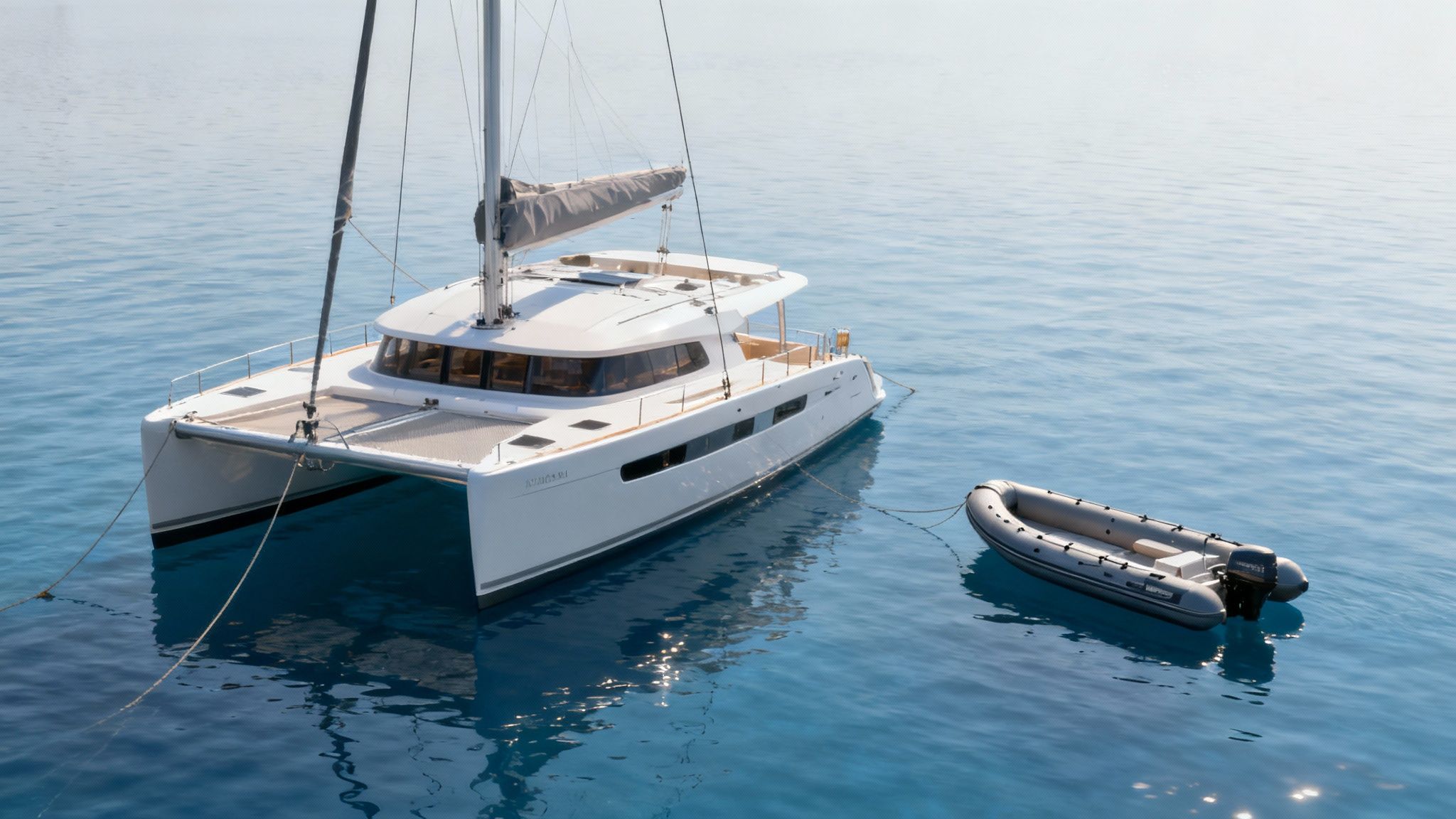
With a spot as famous as Kealakekua Bay, you’ve got options. Lots of them. That's a good thing, because it means there's a perfect trip out there for just about everyone. But it can also feel a bit like trying to spot a specific fish in a massive school—a little overwhelming at first.
The key is to ask yourself one simple question: What kind of day am I really looking for? Are you dreaming of a chill, leisurely cruise with all the bells and whistles? Or are you craving a faster, more rugged, up-close-and-personal ocean adventure? Once you've got that figured out, the choice becomes a whole lot clearer.
Deciding Between Large Catamarans and Small Rafts
Most tours boil down to one major difference: the boat. Think of it as choosing between a spacious, comfy tour bus and a nimble, zippy convertible. Neither is better than the other, they just offer completely different experiences.
-
Large Catamarans: These are the floating resorts of the sea. They’re super stable, which is great if you're worried about seasickness, and they have plenty of room to spread out. You'll often find amenities like restrooms, freshwater showers, sun decks, and sometimes even a waterslide. They're a fantastic pick for families with kids, big groups, or anyone who puts a premium on comfort. Plus, lunch is almost always part of the deal.
-
Zodiac-Style Rafts: These smaller, rigid-hulled boats are all about the thrill. They're much faster, which means less time traveling and more time snorkeling. Because you're sitting so low in the water, you feel incredibly connected to the ocean—every dolphin sighting feels immediate and personal. This is the boat for adventure-seekers who want a high-energy ride and want to get to the reef fast.
Your choice of boat really sets the vibe for the whole day. A catamaran tour is a relaxing day cruise that features amazing snorkeling. A raft tour is a pure ocean adventure that happens to include an epic snorkel stop.
Key Factors to Consider Before Booking
Okay, so you've got a boat style in mind. Now it's time to dig into the details that separate a good trip from a great one. Don't just glance at the price—look at what you're actually getting for your money.
The best value isn't always the cheapest ticket. It's the tour that best aligns with your personal priorities, whether that's maximum in-water time, historical narration from the crew, or premium comfort and amenities for your family.
First, check out the tour duration and group size. A longer tour might mean a second snorkel spot or a more relaxed pace, while a shorter one gets you there and back efficiently. Group size is huge, too. Smaller groups often get a more personalized experience, while larger boats can have a more social, party-like atmosphere.
Next, and this is a big one, look at their safety credentials. You want to be sure the company takes safety seriously. Look for operators that highlight their safety protocols and have lifeguard-certified guides on every trip. It's worth taking a minute to understand the essential USCG boat safety requirements so you know what a professional operation looks like.
Finally, do a little comparison shopping to see what makes each company unique. Some focus on small, intimate trips. Others pack in the amenities on bigger boats. To help you sort through it all, here's a quick look at some of the most popular options.
Comparing Popular Captain Cook Snorkel Tours
Here’s a side-by-side look at some of the top-rated tour operators to help you find the perfect fit for your Kealakekua Bay adventure.
| Tour Operator | Boat Type | Typical Group Size | Price Range | Best For |
|---|---|---|---|---|
| Kona Snorkel Trips | Zodiac-Style Raft | 6-14 passengers | $$ | Adventure-seekers and small groups wanting more in-water time. |
| Fair Wind | Large Catamaran | 50-100 passengers | $$$ | Families and those prioritizing comfort and amenities like waterslides. |
| Sea Paradise | Large Catamaran | 30-49 passengers | $$ | A balance of catamaran comfort with a slightly smaller group feel. |
| Dolphin Discoveries | Zodiac-Style Raft | 14 passengers | $$ | Thrill-seekers interested in exploring sea caves along the coast. |
Remember, the "best" tour is the one that's best for you. Taking a few minutes to weigh these factors will pay off big time, ensuring you book a trip that leaves you with nothing but incredible memories.
Getting Ready for Your Day on the Water
A little bit of prep work is the secret ingredient that turns a good Captain Cook snorkel tour into a truly unforgettable one. Taking a few minutes to think through what you’ll need beforehand means your day will be smooth, comfortable, and all about the incredible underwater world waiting for you in Kealakekua Bay.
Think of it like packing for a day at the world’s most stunning swimming pool—one that just happens to be filled with coral reefs and schools of tropical fish. You'll want the right stuff for comfort and sun protection, and you'll definitely want to capture those amazing moments. A well-packed bag means you won't be kicking yourself over a sunburn or a dead camera when a pod of spinner dolphins decides to show up.
Your Essential Packing Checklist
Having the right gear makes all the difference. While your tour will provide the essential snorkel equipment, a few personal items will seriously upgrade your comfort and enjoyment. Forgetting something as simple as a towel can really put a damper on the experience.
Here’s a simple, must-have checklist to make sure you’re ready to go:
- Reef-Safe Sunscreen: This is an absolute must. Standard sunscreens have chemicals like oxybenzone and octinoxate that are incredibly damaging to coral reefs. Go for a mineral-based, reef-safe option to protect both your skin and the fragile ecosystem you’re there to see.
- Swimsuit and Cover-Up: It’s easiest to wear your swimsuit under your clothes. A light cover-up or a rash guard is also perfect for sun protection while you're on the boat.
- Towel and a Change of Clothes: A quick-dry towel is your best friend here. Trust us, having a dry set of clothes for the ride back to the harbor is a small luxury you'll be glad you have.
- Sun Protection Gear: A wide-brimmed hat, polarized sunglasses, and a long-sleeve sun shirt are non-negotiable. The Hawaiian sun is powerful, and the reflection off the water makes it even more intense.
- Waterproof Camera or Phone Case: You are going to want to take pictures. Whether it's a GoPro or just a waterproof pouch for your phone, be ready to capture the vibrant fish and stunning coral gardens.
- Reusable Water Bottle: Most tours provide water, but bringing your own is a great way to stay hydrated and cut down on single-use plastic.
Staying Safe in the Water
Your safety is the absolute top priority for any reputable tour operator. The crew is highly trained, the boats are loaded with safety gear, and Kealakekua Bay’s waters are naturally calm and protected. But the final piece of the safety puzzle is you.
The most important moment for safety happens before you even get in the water: the crew’s briefing. Listen up! They’ll cover everything from how to use your gear correctly to how to get in and out of the water and what to do if you need a hand. They know this bay's currents and conditions like the back of their hand.
Following your guide's instructions isn't just about rules; it's about respect for the ocean and for the crew responsible for your well-being. Their knowledge is your greatest asset for a safe and enjoyable snorkel.
Once you’re in the water, the golden rule is simple: never touch the coral or marine life. Not only can you damage the delicate coral polyps that have taken centuries to grow, but you can also injure yourself on sharp surfaces or unseen creatures. Appreciate the wildlife from a respectful distance to keep both you and the animals safe. For a deeper dive, our guide on snorkeling safety tips has even more great info.
What to Expect on Tour Day
Knowing the flow of the day helps get rid of any pre-tour jitters and lets you just relax and enjoy the adventure. Most Captain Cook snorkel tours follow a pretty straightforward, well-organized schedule.
You’ll start by checking in with your tour operator at the harbor or meeting point, usually 30 minutes before departure. This is when you'll sort out any final paperwork and get to know the crew. From there, you'll hop on the boat for the scenic trip down the Kona coast to Kealakekua Bay.
Once anchored, the crew will get everyone fitted with snorkel gear and give that all-important safety briefing. Then, it's go time! You’ll have a generous amount of time to snorkel and explore before being called back to the boat for snacks, drinks, and the beautiful, relaxing journey back to shore.
Answering Your Captain Cook Snorkel Tour Questions
Even the most seasoned travelers have a few questions before hopping on the boat. A Captain Cook snorkel tour is a pretty straightforward adventure, but getting a few key details sorted out beforehand means you can relax and just enjoy the day.
We get these questions all the time, so we’ve put together the quick and easy answers. From swimming skills to the best time of year, here’s what you need to know to feel totally prepared.
Is This Tour Good for Beginners or Non-Swimmers?
Absolutely. If you're new to snorkeling, Kealakekua Bay is one of the best places on the planet to start. The water is almost always calm and protected, which makes it far less intimidating than the open ocean.
Tour crews are fantastic with first-timers. They'll give you all the gear you need, including flotation devices like pool noodles or snorkel vests that let you float on the surface with zero effort. They also run through a full safety briefing and give you tips once you're in the water. You don't need to be a strong swimmer, but you should be comfortable floating in the water with the help of a float.
Be sure to tell the crew your experience level when you get on board. They're there to help and can give you extra pointers to make sure you have an amazing—and safe—time. Your comfort is their #1 priority.
When Is the Best Time of Year to Go?
Honestly, there’s no bad time to snorkel Kealakekua Bay. Thanks to Hawaii's incredible weather and the bay's sheltered geography, it's a phenomenal experience year-round.
That said, there are a few little differences between the seasons that might help you decide when to book your Captain Cook snorkel tour:
- Summer (April – October): This is when you'll find the absolute calmest, glassiest ocean conditions. The water clarity is often spectacular, making for a super serene snorkeling experience.
- Winter (November – March): While you might see bigger swells out on the open ocean, the bay itself stays nice and protected. The massive bonus for a winter trip is the chance to see migrating humpback whales on the boat ride out and back!
No matter when you come, the underwater world at the monument is always buzzing with life.
Can I Just Drive to the Captain Cook Monument Myself?
This is a really common question, but the short answer is no, you can't just drive up to it. Looking at a map, it seems close, but there are no roads leading down to the prime snorkeling spot by the monument. That remoteness is exactly what keeps it so pristine.
Trying to get there on your own is a serious undertaking and not something we'd recommend. The only options are a grueling 3.75-mile hike each way down (and back up!) a steep, hot, and rocky trail, or kayaking across the bay, which requires a hard-to-get landing permit.
A licensed boat tour is, by far, the easiest, safest, and most fun way to see the bay. The tour operators handle everything—the boat, the gear, the safety, the food—so all you have to do is show up and soak in the incredible views.
What Is Typically Included in the Tour Price?
While the specifics can change a little from one company to the next, almost every Captain Cook snorkel tour will have the essentials covered, which makes your life a lot easier.
You can pretty much always count on these being included:
- High-quality snorkel gear (mask, snorkel, and fins)
- Flotation devices (noodles, vests, or float belts)
- Snacks and beverages (think fruit, chips, water, and juice)
Longer trips, especially the midday ones, will often include a full lunch like deli sandwiches or wraps. If you're on a bigger boat like a catamaran, you might also get perks like an onboard restroom, a freshwater shower to rinse off, and plenty of space to spread out in the sun. It's always a good idea to double-check the tour description when you book so you know exactly what's provided.
Ready to experience this underwater paradise for yourself? Kona Snorkel Trips offers world-class adventures to Kealakekua Bay, led by lifeguard-certified guides who are passionate about sharing Hawaii's marine wonders safely and respectfully. Book your unforgettable Captain Cook snorkel tour today at https://konasnorkeltrips.com.
